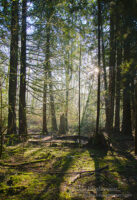Contrary to much (Internet) wisdom. you do not need to use a Mac to create art. You don’t need to use Microsoft or Adobe software either. I use a Linux operating system for a number of reasons I may explain in another post. (if you are interested, start on the Ubuntu page)
Let me walk through my work-flow. After a photo shoot, I download my photos to my computer with a handy program called Rapid Photo Downloader. This program automatically moves all the photos on the card to my photo directory in sub-folders based on the date of the photo (taken from the cameras EXIF information). It also renames the file to include the daymonthyear of the image. In other words, I have a directory for each year, then each month, then each day containing the photos taken that day (photos/2011/01/22/22012011-sample.raf*) This program also clears the card once all the photos are transfered. I have heard some people say they like to keep all the photos on the card until they confirm that the photos have been correctly transfered, but I have never had a problem. OK, once, when my laptop was stolen, I had to use a recovery program to retrieve photos from a card, but that was trivial (and a topic for another post…)
OK, so I have my photos on my computer. Now I use a program called Digikam to view and organize the images. Digikam, like many photo organization programs (commonly called Digital Asset Management or DAM programs…. possibly for a good reason…) allows you to rate and “tag” your photos. Without changing the location of the files, a good DAM program will let you attach various labels to your photos; Goldstream Park, Kids, Snow, etc. as well as give a rating from one to 5 stars. At this point I also delete any obvious failures, such as missed focus, accidental exposures, etc. I will admit that this is my weakest area. I am not good at tagging my photos.
When I find a photo that looks like it has potential, I open it in RawTherapee. This program has gone through quite a few changes in the last little bit, and as of this date it still needs a bit of polish, but I have found the files it produces from my RAF captures to be the best I can get. This program does most of the heavy lifting. I adjust white balance, exposure via curves, any cropping, rough colour saturation, resizing, and depending on the image, sharpening. I save a copy of the file as a png or tif in a sub-folder named “converted”.
My final step is a standard photo-manipulation program. I usually use Gimp because it integrates well into Linux. Arguably PhotoShop is a better program, but I find it is usually a bit of overkill for what I want.
In Gimp I do a final curves adjustment (Yet another subject for a post), spotting (removing dust spots on the sensor) if required, dodging and burning, and any selective area adjustments. While I am working on a file I keep a copy in Gimps native format in another subfolder called “working”. When I am done I make a print and a small jpg copy for my website.
When all is said and done, I will have 4 copies of a “good” image. The original in a dated folder. A transitional file in a converted folder (I guess I should really delete this one once I have tweaked it, but hard drive space is cheap…) and two final files, one full size and one small jpg.
This system works for me. All the software is open-source and free (RawTherapee was the last holdout) and most importantly continually improving. I have tried a number of other systems, and each has strengths and weaknesses, and I am sure each appeals to different people. My point is that you don’t need to spend thousands of dollars to get great quality software. In the words of a bit of a dated cliche: software free, final print priceless!
*I shoot almost exclusively raw files. Again, a subject for another post. As of this date I shoot with an old Fuji S2 digital SLR, but I do have my eye on a new D7000…..
